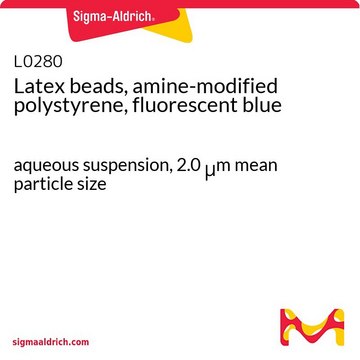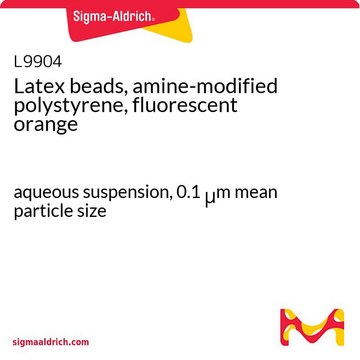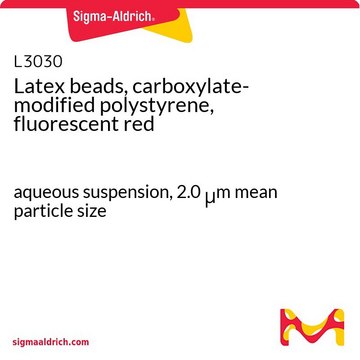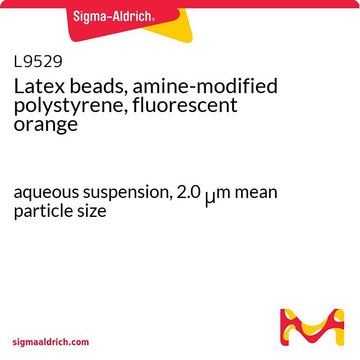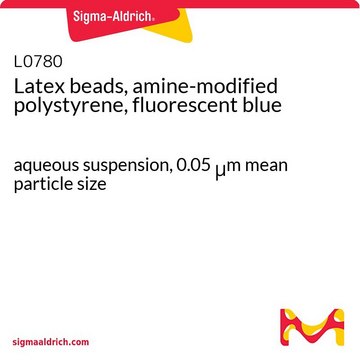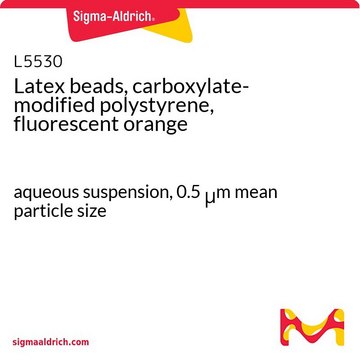L1030
Latex beads, amine-modified polystyrene, fluorescent yellow-green
aqueous suspension, 1.0 μm mean particle size
Zaloguj sięWyświetlanie cen organizacyjnych i kontraktowych
About This Item
Polecane produkty
Postać
aqueous suspension
Poziom jakości
skład
Solids, 2.5%
metody
cell based assay: suitable
średnia wielkość cząstek
1.0 μm
fluorescencja
λex ~470 nm; λem ~505 nm
Zastosowanie
cell analysis
Szukasz podobnych produktów? Odwiedź Przewodnik dotyczący porównywania produktów
Zastosowanie
Latex beads, amine-modified polystyrene, fluorescent yellow-green have been used:
- in the characterization of nano- and microplastics
- in tendon preparation to label tendon fascicles to enable precise localization of the tissue surface
- in phagocytosis assay to label spleen cells
Działania biochem./fizjol.
Polystyrene latex beads can be used to create latex agglutination systems. It can be used to study the transmission of Mycobacterium leprae, the causative pathogen of leprosy. These beads are also utilized to develop a method for mass screening for both pulmonary and extrapulmonary tuberculosis.
Ta strona może zawierać tekst przetłumaczony maszynowo.
Kod klasy składowania
10 - Combustible liquids
Klasa zagrożenia wodnego (WGK)
WGK 2
Temperatura zapłonu (°F)
Not applicable
Temperatura zapłonu (°C)
Not applicable
Certyfikaty analizy (CoA)
Poszukaj Certyfikaty analizy (CoA), wpisując numer partii/serii produktów. Numery serii i partii można znaleźć na etykiecie produktu po słowach „seria” lub „partia”.
Masz już ten produkt?
Dokumenty związane z niedawno zakupionymi produktami zostały zamieszczone w Bibliotece dokumentów.
Klienci oglądali również te produkty
Sean Spanik et al.
Journal of contaminant hydrology, 243, 103919-103919 (2021-11-12)
The transport of cationic amine-modified latex (AML) and anionic carboxylate-modified latex (CML) microspheres through a discrete sandstone fracture with mineralogical heterogeneity and roughness was studied. Two microsphere sizes (200 nm and 1000 nm), two ionic strengths (5 mM and 10 mM), and two specific
Ivan Gusachenko et al.
Biophysical journal, 102(9), 2220-2229 (2012-07-25)
Collagen is a triple-helical protein that forms various macromolecular organizations in tissues and is responsible for the biomechanical and physical properties of most organs. Second-harmonic generation (SHG) microscopy is a valuable imaging technique to probe collagen fibrillar organization. In this
James M May et al.
Archives of biochemistry and biophysics, 440(2), 165-172 (2005-08-02)
Since activated macrophages generate potentially deleterious reactive oxygen species, we studied whether ascorbic acid might function as an antioxidant in these cells. Thioglycollate-elicited murine peritoneal macrophages contained about 3 mM ascorbate that was halved by culture in ascorbate-free medium. However
Jing Liu et al.
Fish & shellfish immunology, 82, 136-146 (2018-08-14)
Clam Ruditapes philippinarum is one of the most important commercial aquaculture species in China. The haemocytes play vital roles in internal defense of the calm. In this investigation, classification and immune functions of R. philippinarum haemocytes were identified. The haemocyte
Fancong Kong et al.
Experimental and therapeutic medicine, 10(6), 2093-2101 (2015-12-17)
Microvesicles (MVs) in body fluids participate in a variety of physical and pathological processes, and are regarded as potential biomarkers for numerous diseases. Flow cytometry (FCM) is among the most frequently used techniques for MV detection. However, different handling methods
Nasz zespół naukowców ma doświadczenie we wszystkich obszarach badań, w tym w naukach przyrodniczych, materiałoznawstwie, syntezie chemicznej, chromatografii, analityce i wielu innych dziedzinach.
Skontaktuj się z zespołem ds. pomocy technicznej

